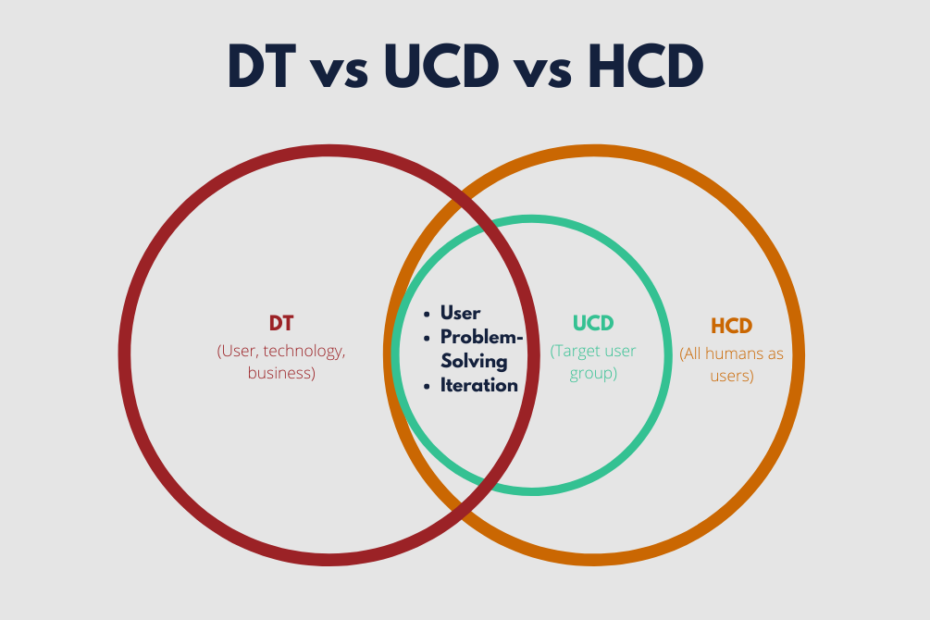In the world of product development and User Experience (UX) Design, there are three buzzwords that you would have heard being thrown around:
- Design Thinking,
- User-Centred Design, and
- Human-Centred Design.
Now, at first glance, they might appear to be very similar and somewhat confusing (as they did to me). However, as I dived deeper into the subject, I realised that although these frameworks use very similar methodologies, there are some key differences.
Here is what I will cover in this blog:
- What is a design framework?
- Design Thinking (DT)
- User-Centred Design (UCD)
- Human-Centred Design (HCD)
- What are the key differences?
- What do they have in common?
- In a nutshell
Alright, let’s get into it!
What is a design framework?
Most industry professionals follow a specific framework or a set process when working on a design project. A framework is defined as the basic underlying structure that acts as a guide and supports the problem that you are trying to solve. Much like a recipe, a framework provides you with a set of instructions and an ingredient list of tools and techniques to produce a specific result.
Design Thinking (DT), User-Centred Design (UCD) and Human-Centred Design (HCD) are amongst the most commonly used design frameworks.
Design Thinking (DT)
Design is an age-old concept. Most of the things we surround ourselves with today are a result of meaningful and effective design, be it buildings, automobiles, clothes, or even the device you are reading this blog post on. Despite a long and successful history of thoughtfully designed products, in the world of traditional business, design has often been applied as a mere after-thought to spruce up a product’s aesthetics. This has resulted in many products that have failed to meet the user requirements. Consequently, many corporations have realised the importance of including designers at the very beginning of the process, rather than at the end where the impact of their work is minimal.
This concept soon caught on, and it led IDEO to coin its own term for the process. In the 1990s, David Kelley, Tim Brown (CEO, IDEO), and Roger Martin formalised the creative design process into a unified framework called Design Thinking.
Design Thinking (DT) is an approach to problem-solving that aims to integrate the needs of the people, the technical feasibility of the design, and ensure that the requirements for business are fulfilled.
The Design Thinking Process
Design Thinking has five core steps:
- Empathise: Understand user needs and how users feel and think. Involves extensive user research to understand the users and the challenges they face.
Who is my user? What matters to this person?
- Define: Build a problem statement based on your user research findings or describe the user’s needs that you aim to address.
What are my user’s needs?
- Ideate: Land on a user problem and establish why it’s important to solve. Brainstorm and come up with as many design solutions as possible.
How can I solve my user’s problem?
- Prototype: Demonstrate the functionality of one or more of your designs in the form of a rough draft.
How can I illustrate my idea?
- Test: Share and test your prototyped design with your users and gather their feedback.
What did my users like? What didn’t they like?
Design Thinking is an iterative process, meaning you can repeat the entire process or specific steps as needed. Depending on the feedback at each of these core steps, you might need to jump back to the previous steps and repeat them. For instance, if a new problem appears in the prototype phase, and it was not covered in your user research, you might need to go back to the Empathise and Define phases.
For me, design thinking is about being more receptive to a plethora of ideas and not getting attached to one specific solution. Design Thinking promotes collaboration and is a great way for an individual or a team to come up with some truly creative and useful solutions, while primarily focussing on the user’s needs.
For further reading about the Design Thinking process, check out Adobe XD’s guide to UX Design Process: Everything You Need to Know.
Also, check out 5 Examples of Design Thinking in Business for more inspiration.
User-Centred Design (UCD)
In User Experience (UX) Design, one of the most important terms is “user”. All decisions are taken keeping the user in mind. But why is it important that designs are centred on the user? Because the user buys and uses your product.
User-Centred Design (UCD) puts the user front and centre. The user is involved in the design process early on, and the focus is primarily on the users, their story, emotions, insights and problems. A clear understanding of the user needs and regular analysis and incorporation of user feedback is crucial.
The User-Centred Design Process
The UCD process has 4 steps:
- Understand how the user experiences the product or similar products.
- Specify the end user’s needs.
Which user problem is the most important to solve?
- Design solutions to the end user’s problems through storyboards, user journey mapping, wireframing, design mock-ups and user flows.
How do I solve a user problem? How do I demonstrate my design?
- Evaluate your design against your end user’s needs by conducting usability tests and gathering feedback.
Does the design solve the user’s problem? What is working well? What can be improved?
The UCD process, like Design Thinking, is also iterative. Designers might need to go back to earlier steps to make corrections and improvements to their designs based on the user feedback.
User-Centred Design puts the user front and centre. It is important for you as a designer to recognise and learn about your users. The better your understanding of your user, the more effective design solutions can be. A good user-centred design is intuitive and easy to use and prevents future service delivery problems, which in turn can save you time and money.
If you want to learn more about the UCD process, head to User-Centred Design Principles & Methods by Adobe XD.
Human-Centred Design (HCD)
Human-Centred Design (HCD) is a step above User-Centred Design (UCD).
The term Human-Centred Design (HCD) was coined in the late 1970s by computer scientist Rob Kling. It became more popular when Don Norman featured the concept extensively in his book The Design of Everyday Things (1988). In the words of Norman, “human-centred design (HCD) is an approach that puts human needs, capabilities, and behaviour first, then designs to accommodate those needs, capabilities, and ways of behaving”.
Human-Centred Design (HCD), aka universal design, is a design philosophy that aims to include all humans as possible users of a product. It ensures that the design matches the needs and capabilities of all users. This approach is often used while designing solutions to problems that exist across physical, economical and social interactions.
The goal of HCD is to make every user feel that the experience was designed just for them, no matter who they are, where they live, or what they do for a living. The core of HCD is deep empathy. Designers must let go of their inherent biases and assumptions based on their own experiences and be more perceptive of how others might experience the product.
Learn how to understand your users better with UX research:
Principles of Human-Centred Design
HCD has four principles:
- People-centred: No matter what you are designing, always think of the people who will use your product. It is important for you, as a designer, to identify the real reason why people would want to use your product.
Who will be using this product? When, where, and how will it most likely happen?
- Solve the root problem: Understand and work out the core problem and address the root causes of the problem. If this step is skipped, it could lead to a situation where you are trying to solve the wrong problem.
What are the symptoms of the problem? What is the fundamental problem causing the symptoms?
- Everything is a system: Think of everything as a system with interconnected parts. Try not to focus solely on one part of the user journey, while ignoring the rest. Always keep the big picture in mind. Your users should have a good user experience at all physical and digital touchpoints.
What do I want the users to achieve by using my product? How can I improve the overall user experience?
- Small and simple interventions: Small and regular iterations are crucial. Consistent prototyping and testing with real users is the key to creating designs that will help achieve the real user needs. The feedback from user testing will help you understand which parts of your design require improvement and refinement.
What can be improved? What is working well with the users?
Check out Google Next Billion Users for some inspiration and examples of how Google is creating products for users all across the globe by using a very human-centric design mindset.
What are the key differences?
Now that we have a brief overview of the three design frameworks, you might still be wondering how is one different from the others? While the general steps of each are quite similar, the most significant difference lies in each methodology’s primary focus.
- Design Thinking (DT) looks at the bigger picture. While it also requires abundant knowledge of the user, it also takes into account the technical feasibility of the product and the goals of the business. DT aims to identify and solve rather complex problems that may have an impact on product design, organisational policies and processes.
Human-Centred Design (HCD) and User-Centred Design (UCD) are similar, but not the same thing.
- UCD, as suggested by the name, puts the focus solely on a target group of users in the design process. UCD aims to understand and design for a predicted user group of the end product.
- HCD methodology aims to include all humans as possible users of a product. This means that the design and research phase should focus on all humans as potential users of the product, and not just a specific target group. HCD is all about inclusivity and accessibility.
Design Thinking (DT) is a process, whereas Human-Centred Design (HCD) and User-Centred Design (UCD) are mindsets.
What do they have in common?
Now that we have looked at the differences in the primary focus of these design methods, let’s consider the common aspects they share.
- User: It is key for UX designers to understand the feelings, fears, limitations and frustrations of their users. It is good to look past the overt needed of the users and have a deep understanding of what the user needs. Empathising with your user is pivotal, no matter which design methodology you choose to follow.
- Problem Solving: All 3 of the design frameworks discussed here share a common optimistic approach to problem-solving, and view user problems as opportunities for improvement.
- Iteration: The processes for DT, HCD, and UCD are not linear. They heavily rely on the design team learning from their mistakes and making constant improvements based on feedback at all stages.
In a nutshell
Despite their subtle differences, the three methodologies can be used in conjunction for creating products and services that aim to resolve real user problems. The question is not which of the three you should use for your next project. Instead, consider how you can use all three together to get positive results and create feasible, viable, and desirable products.


